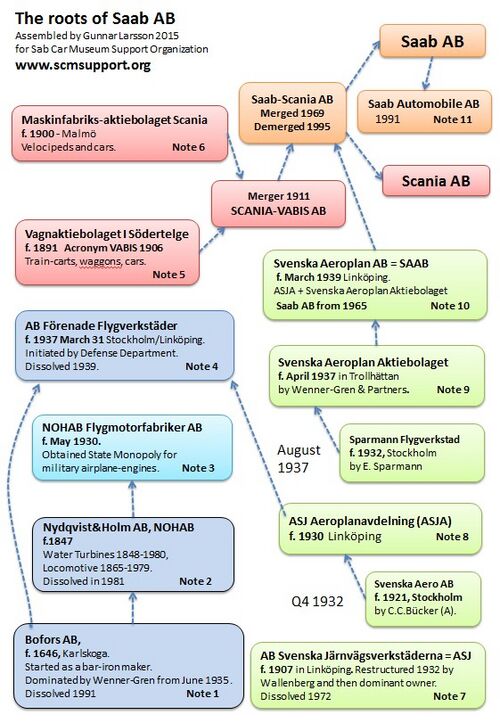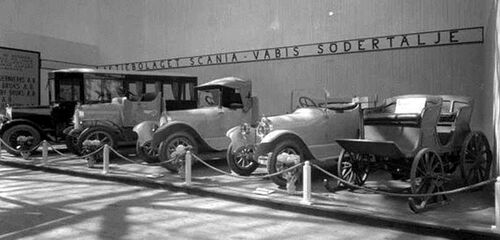The roots of Saab AB (a short version)
SAAB Veteranerna
This is the short version of this article, if you prefer the long version, click here.
When new facts appear or errors are identified, text will be corrected accordingly.
Innehåll
- 1 Bofors AB, f. 1646
- 2 Nydqvist & Holm AB, f. 1847
- 3 NOHAB Flygmotorfabriker AB, f. May 1930
- 4 AB Förenade Flygverkstäder, f. 1937 March 31
- 5 Vagnaktiebolaget i Södertelge, f. 1891
- 6 Maskinfabriks-aktiebolaget Scania, f. 1900
- 7 AB Svenska Järnvägsverkstäderna =ASJ, f. 1907
- 8 ASJ Aeroplanavdelning =ASJA, f.1930
- 9 Svenska Aeroplan Aktiebolaget, f. April 1937
- 10 Svenska Aeroplan AB =SAAB, f. March 1939
- 11 Saab Automobile AB, f. 1991
- 12 Sources for Roots of Saab
Bofors AB, f. 1646
Note 1
Bofors Hammarbruk AB, a tilt-hammer factory using bar iron as raw material was founded 1646 in Karlskoga Sweden.
Since late 1860s only steel-maker Krupp were able to produce enough high steel-quality for more efficiently working rear loaded cannons.
In 1879 Bofors made a metallurgic break-through after systematic trials.
Bofors was able to deliver the new better quality of cast steel to be tested by Swedish Army.
In the aftermath of WW1 peace agreement, Krupp and Bofors agreed on future cooperation in October 1919.
After emission of new Bofors shares in Februari 1921, Krupp paid 4.5 million SEK for 25 % of Bofors shares via an intermediate company called AB Bofors stakeholders (AB Bofors-intressenter).
A War Material Agreement was agreed upon with the Swedish Defence Department in1921, valid until June 30, 1941.
After long negotiations, chairman Sven Wingquist at Bofors AB succeeded to convince Krupp to sell its shareholding in Bofors to Swedish owners on June 4th 1935.
Short Version 1.0. May 18, 2015.
Nydqvist & Holm AB, f. 1847
Note 2
Nydqvist & Holm AB, founded in 1847, acronym NOHAB. Manufactured large Water Turbines from 1848-1980. Most known by public as Locomotive maker producing ≈ 2300 from 1865 until 1979.
Won a historic order from Soviet Union for 500 large steam locomotives 1920. Paid with 56 000 kg pure gold (123 500 lbs)! Last one of the 500 Locomotives was delivered in 1924.
Bofors AB became majority owner of NOHAB in March, 1936 to provide more manufacturing capacity for the quickly increasing market demand for their world leading 40 mm anti-aircraft guns. The Bofors subsidiary name Bofors Nohab AB.
Short Version 1.0. May 18, 2015.
NOHAB Flygmotorfabriker AB, f. May 1930
Note 3
NOHAB Flygmotorfabriker founded 1930(≈ NOHAB Airplane Engine Factories).
The company had got a license in 1930 to produce Bristol Aeroplane Co. engines.
Awarded state monopoly to deliever 165 airplane engines before 1943.
Produced Jet Engines for all Swedish Jet Fighters since the late 1940s.
Volvo AB became majority owner from 1941. Name change to Volvo Aero AB 1994.
GKN PLC (GKN Aerospace) bought Volvo Aero AB in October 2012.
Short Version 1.0. May 18, 2015.
AB Förenade Flygverkstäder, f. 1937 March 31
Note 4
AB Förenade Flygverkstäder, (≈ United Aviation Engineering Inc.), enforced by the Swedish State, founded March 31 1937. Acronym AFF. Owned by ASJ AB and Nohab Bofors AB as a Holding company. AFF was awarded government contract April 1937 to deliver 165 airplanes within 5 years to Swedish Defense Department. AFF task was to handle allocation of development work and production to the competing owners. The owner groups did not agree on how to cooperate and the company lost its role.
Short Version 1.0. May 18, 2015.
Vagnaktiebolaget i Södertelge, f. 1891
Note 5
Vagnaktiebolaget i Södertelge (Wagon Inc. in Sodertalje) f. 1891.
Surahammars bruk created a subsidiary to increase the use of company produced iron e.g. for rail carriages and waggons until 1911. Acronym VABIS registered 1906. Manufactured very few trucks from 1902 and cars from 1903 to1909.
After 1929 only buses and trucks.
Short Version 1.0. May 18, 2015.
Maskinfabriks-aktiebolaget Scania, f. 1900
Note 6
Maskinfabriks-aktiebolaget Scania (Machine factory Scania Inc.) f. 1900 in Malmö. Scania took over the operation from English-owned Svenska Aktiebolaget Humber & Co producing Humber velocipeds on license from 1896.
Scania bought the operation in 1900 producing velocipeds until 1909 but mainly precision cog-wheels and various machines. From 1901 a few cars and trucks were produced. After Scania-Vabis merger trucks and buses were produced in Malmö until 1926.
Short Version 1.0. May 18, 2015.
AB Svenska Järnvägsverkstäderna =ASJ, f. 1907
Note 7
AB Svenska Järnvägsverkstäderna, (Swedish Railway Factories Inc.), acronym ASJ AB, was founded by the brothers Erland and Carl-Johan Uggla.
ASJ produced e.g. train wagons, locomotives, bus-bodies. Aeroplane manufacturing started in small scale 1930 in its subsidiary ASJA, see Note 8.
Short Version 1.0. May 18, 2015.
Note 8
ASJ Aeroplanavdelning (short ASJA) (short ASJA) founded 1930. During the 1930s ASJAs mainly manufactured airplanes on license from German, English and American companies. In 1937 ASJA and Saab Aeroplan Aktiebolaget merged and changed the name, now called Svenska Aeroplan AB .
ASJA acquired Svenska Aero AB
ASJA acquired Svenska Aero AB (Swedish Aero Inc.) founded September 1921 in Stockholm by C.C. Bücker who had worked as test pilot for TDS (Swedish Marine Airplanes) 1921-22. Swedish Aero Inc. produced airplanes on license from Casparwerke. Bücker met the airplane developer Ernst Heinkel when he worked at Casparwerke. Ernst Heinkel helped Svenska Aero ABs business. Late in 1932 ASJA bought Svenska Aero AB
Short Version 1.0. May 18, 2015.
Svenska Aeroplan Aktiebolaget, f. April 1937
Note 9
“Svenska Aeroplan Aktiebolaget” was founded in Trollhättan April 20 1937 as a subsidiary to Bofors-NOHAB, with a capital of 4 million Swedish Kroner with Axel Wenner-Gren CEO and dominating owner. The company started with few engineers in existing NOHAB buildings. New quite large manufacturing facilities for airplanes were built North of Trollhättan, ready in the summer 1938.
Factory facilities still exist in 2015, Saab 92 production started there late 1940s.
Svenska Aeroplan Aktiebolaget acquired “Sparmann Flygverkstad (Airplane workshop)” in August 1937 to get the company’s competence on airplane design.
Austrian Edmund Sparmann founded the company in 1932. He worked as test pilot and engineer at the Austrian company Phönix Flugzeugwerke A.G. and moved to Sweden in 1919 to demonstrate two different Phönix airplanes for the Swedish Army.
Short Version 1.0. May 18, 2015.
Svenska Aeroplan AB =SAAB, f. March 1939
Note10
The new company “Svenska Aeroplan AB” (Swedish Airplane Inc.) was created April 1937 by combining ASJA and Svenska Aeroplan Aktiebolaget in Trollhättan.
Svenska Aeroplan AB was controlled by Wallenberg through Investor AB.
The HQ was placed in Linköping. Military airplanes have been developed, produced, tested in Linköping since 1939.
Airplanes were built until 1948 in Trollhättan, major components as wings for jet planes were built until 1959. In 1965 company name changed to Saab AB.
Short Version 1.0. May 18, 2015.
Saab Automobile AB, f. 1991
Note 11
Saab Automobile AB was founded as a Joint Venture between Saab AB and General Motors GM, active from 1991.
In 1972 Saab Car division had been formed. Sten Wennlo was selected as CEO for Saab Cars. Finance, car sales and marketing were located in Nyköping.
Manufacturing of cars and Product Development took place in Trollhättan.
Still insufficient knowledge how Saab Car business was managed in detail inside Saab AB 1945-1972. Hopeful to find documents in Saab Car Museum Archives.
Short Version 1.0. May 18, 2015.
Sources for Roots of Saab
Bofors . “En kanonindustris historia” av Birger Steckze’n
Bofors. History of a Cannon industry printed by Esselte Aktiebolag, Stockholm 1946.
SKF- Världsföretaget. 1907-2007, by Martin Fritz and Birgit Karlsson
ISBN 978-91-7736-575-4 Informationsförlaget Stockholm
www.informationsforlaget.se
English version. SKF- A global company 1907-2007
Svenska Flygplan, Den svenska flygindustrins Historia by Lennart Andersson.
(History of Swedish Aviation Industry) written for Publisher “Allt om Hobby”,
Box 42006, 12612 Stockholm, 1990. The best book on Swedish Aviation.
ISBN 91-85496-33-2
Aktiebolaget Svenska Järnvägsverkstäderna in Linköping 1907-1972
av Bengt-Åke Rundström (red) Swedish language only.
Published by Trafik-Nostalgiska Förlaget 2007. ISBN789-91-85305-45-2
Linköpingskarosserier. By Bengt-Åke Rudström, Bus-bodies from Linköping
Published by Trafik-Nostalgiska Förlaget 2012 ISBN 978-91-86275-97-6
En bok om Saab-Scania (A book about Saab-Scania) Rolf Erichs et al, 1987, Streiffert,
ISBN 91-7886-014-8. Issued to Saab 50 year jubilee by Saab Scania A English language version “The Saab-Scania story” ISBN 91-7886-024-5.
I do recommend reading the book, has a lot of information and pictures for all business areas in Saab-Scania AB, concentrated on Saab products.
Scania 100 år - 1891-1991 (Scania 100 years) by Kaj Sandell, Bo Streiffert et al.
Published by Saab-Scania AB, Scaniadivisionen 1990. ISBN 91-7886-065-2 Available in English, German, French and Finnish languages.
SAAB 75 år (SAAB 75 years) by Ulf Edlund, Arne Fagerstedt, Hans Kampf,
Published 2012 by Svensk Flyghistorisk Förening (www.flyghistoria.org).
ISSN 1100-9837. A cooperation between Svensk Flyghistorisk Förening (Swedish Aviation Historical Society) and Veteranklubben Saab Linköping.
Short history of Saab and its background and information on airplane types used by Swedish Air Force from 1931 onwards. A very readable, trustworthy 40 pages booklet.
Page 39 contains a list of Swedish Aviation literature published 1977-2007.
Flygvapennytt 3/97, Saab 60 År by Gert Peterson (Air Force News 3-97- Saab 60 years)
Swedish language only.
NOHAB Locomotives by NOHAB Trollhättan, Sweden
NOHAB No. 733. (Info from 1st locomotive to ca 1967).Faksimil from Trafik-Nostalgiska Förlaget, 2010.
Not available in English.
Four Biographies about members of Wallenberg family in Swedish
1 - Wallenbergs, by Staffan Tjerneld, 1969, Bonniers Förlag
2 - Att förvalta sitt pund. Marcus Wallenberg 1899-1982, by Ulf Olsson, 2009 Ekerlids förlag, ISBN 91-88595-75-7
3 - Wallenberg. Ett familjeimperium , Gunnar Wetterberg 2013, 978-91-0-013416-7. Albert Bonnier Förlag, www.albertbonnierforlag.se
4 - Finansfursten K.A. Wallenberg 1853-1938 by Ulf Olsson 2006, Bokförlaget Atlantis. ISBN 91-73531-36-7

